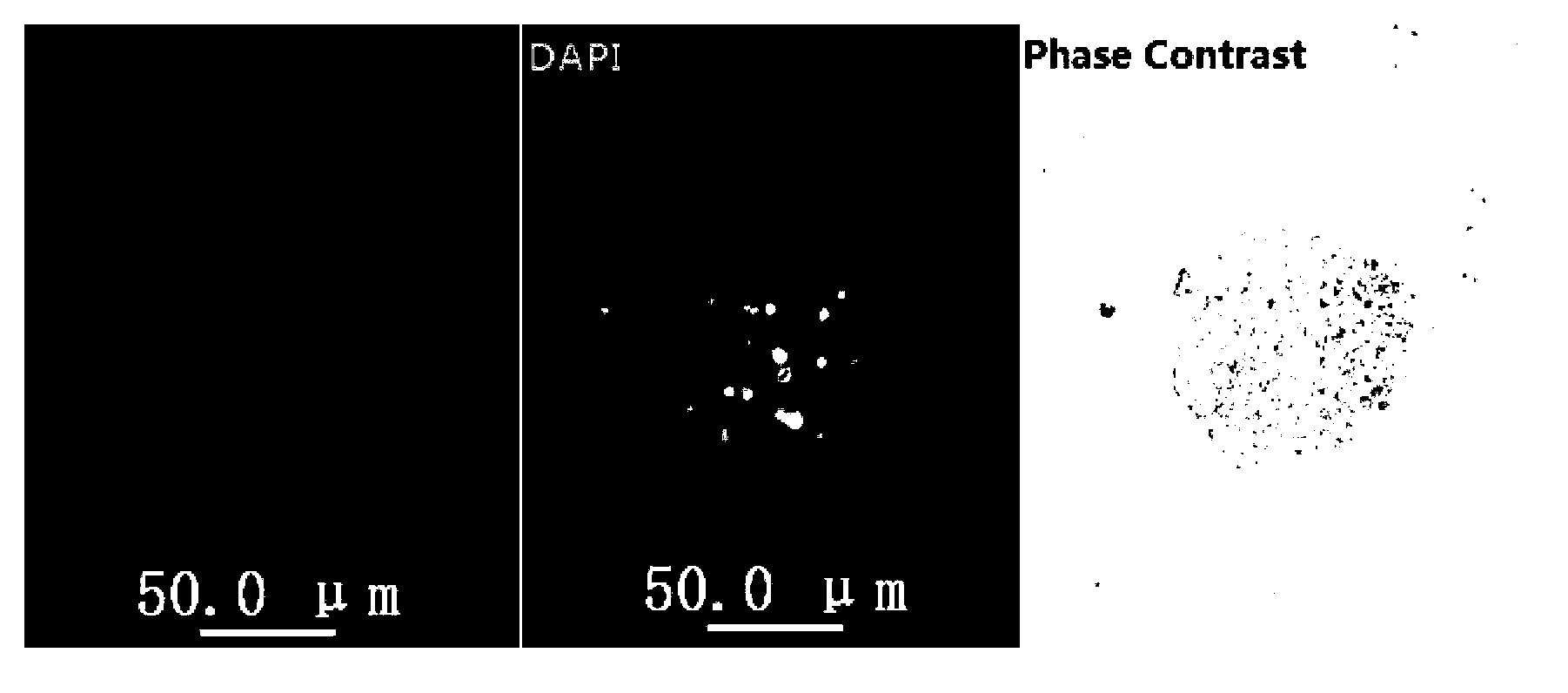Method of efficiently separating embryonic stem cells of poultry
A technology of embryonic stem cells and blastodisc cells, which is applied to embryonic cells, germ cells, animal cells, etc., can solve the problems of cumbersome operation, low survival rate, and cumbersome and complicated methods of hair ring method, and achieve simple and easy methods and improve survival High rate, repeatable effect
- Summary
- Abstract
- Description
- Claims
- Application Information
AI Technical Summary
Problems solved by technology
Method used
Image
Examples
Embodiment 1
[0049] Example 1 Obtain all blastodisc cells from a chicken egg that has just been born, digest and clean them, and carry out primary culture
[0050] 1. Lay the breeding eggs of chickens that have been cleaned and disinfected with bromogeramine and stored at 2-6°C for 0-2 days after production, and placed in a low-temperature freezer overnight;
[0051] 2. Keep the laying eggs horizontally, move them into the ultra-clean workbench, and disinfect with alcohol cotton balls at the highest point of the equatorial surface of the eggs and a radius of 2-3cm around them;
[0052] 3. Use sterile ophthalmic tweezers to open a window with a radius of 2 cm at the highest point of the equatorial surface of the laying eggs, and you can see the position of the germinal disc directly below it;
[0053] 4. Use ophthalmic scissors to cut the vitelline membrane around the blastodisc;
[0054] 5. Use a pipette gun equipped with a 1ml sterilized tip with a cut-off tip of about 0.5-1cm to aim at ...
Embodiment 2
[0063] Example 2 Enrichment and Purification of Embryonic Stem Cells from Primary Cultured Blastodisc Cells
[0064] 1. Take out the culture dish after primary culture for 24 hours, tilt it at 30°, and use a 5ml pipette to collect the culture medium;
[0065] 2. Filter the medium through a sterilized cell sieve with a mesh opening size of 40 μm to remove dead cells and blastoderm hypoblast cells;
[0066] 3. Invert the cell sieve, place it on another Petri dish, and elute with 5ml of fresh serum-free mTeSR1 medium containing Y-27632 at a final concentration of 10μM / ml to obtain a large amount of enriched and purified Embryonic stem cells from the blastoderm epiblast.
[0067] There may be a small amount of vitelline membrane fragments remaining in the above process, which can be removed with a pipette gun under a stereoscopic microscope; the enriched and purified chicken embryonic stem cells can be used for subsequent gene transfection operations, and can be used to prepare t...
Embodiment 3
[0068] Example 3 The isolated and cultured primary chicken embryonic stem cells were identified by SSEA-1 and DAPI staining
[0069] The separated and purified chicken embryonic stem cell pellets were transferred to ordinary cell culture dishes, and their morphology was observed the next day (24 hours) after their adherent culture.
[0070] 1. Fix the adherent embryonic stem cell samples in 4% paraformaldehyde for 10 minutes, wash with PBS twice, 5 minutes each time;
[0071] 2. Add 0.3% Ttiton-X1002mL, place at room temperature for 10min, then wash twice with PBS, 5min each time;
[0072] 3. The sample was blocked in 5% BSA for 20 minutes, and the primary antibody (mouse anti-SSEA-1 IgM) was diluted with PBS at a dilution ratio of 1:500. The sample was incubated with the primary antibody for 1 hour at room temperature, and then washed twice with PBS, 5 minutes each time;
[0073] 4. The secondary antibody used is biotinylated goat anti-mouse IgM, diluted 1:100 with PBS, incu...
PUM
| Property | Measurement | Unit |
|---|---|---|
| size | aaaaa | aaaaa |
| diameter | aaaaa | aaaaa |
Abstract
Description
Claims
Application Information
 Login to View More
Login to View More - R&D
- Intellectual Property
- Life Sciences
- Materials
- Tech Scout
- Unparalleled Data Quality
- Higher Quality Content
- 60% Fewer Hallucinations
Browse by: Latest US Patents, China's latest patents, Technical Efficacy Thesaurus, Application Domain, Technology Topic, Popular Technical Reports.
© 2025 PatSnap. All rights reserved.Legal|Privacy policy|Modern Slavery Act Transparency Statement|Sitemap|About US| Contact US: help@patsnap.com


